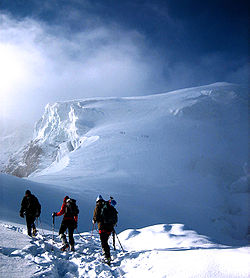A rope team (sometimes also called moving together) is a climbing technique where two or more climbers who are attached to a single climbing rope move simultaneously together along easy-angled terrain that does not require points of fixed climbing protection to be inserted along the route. [1] Rope teams contrast with simul-climbing, which involves only two climbers and where they are ascending steep terrain that will require many points of protection to be inserted along the route. A specific variant of a rope team is the technique of short-roping , which is used by mountain guides to help weaker clients, and which also does not employ fixed climbing protection points. [2]
Contents
Rope teams are commonly used in alpine climbing, particularly for moving across glaciers and traveling along snow slopes and ridges. [1] [3] Members are typically spaced 30 feet (9.1 metres) apart with any surplus rope coiled and carried by the first and last members. [1] [3] The weaker members of the team are placed in the middle, however, it is important that the team can move together in a way that the rope does not become excessively slack or taught. [1] [3] Rope teams can accommodate many climbers, which gives greater "holding power" if a member falls into a crevasse or slides down a snow slope. [1] [3] However, large teams are also less flexible, which is a problem on more varied terrain where the rope team might want to quickly change to a short-roping or even a simul-climbing format. [1] [3]
Some rope teams will simply tie each member directly into the rope via a climbing knot (e.g. figure-eight on a bight attached to a screw-gate carabiner), however, members can also be attached via prussik knots or progress capture devices for greater flexibility. [1] When crossing glaciers, some rope teams will pre-apply prussik knots and loops to the rope to speed up the rescue of any member who falls into a crevasse, however, some don't as these knots and loops can make the rope more difficult to manage. [3] When small rope teams of 2-3 climbers are crossing glaciers, additional knots can be added to the rope to act as a partial brake against a crevasse lip in the event of a fall. [4] On exposed snow slopes, rope teams may use snow anchors as points of climbing protection — as in simul-climbing — to prevent a falling member from dragging the entire team down the slope before they can self-arrest. [1] [3]
Various records have been set for the longest climbing rope-teams at various altitudes. [5] In July 2017, the Italian Alpine Club set a Guinness World Record for the world's longest static rope team when 2,846 climbers were connected to a single rope in Bergamo in Italy. [6] In 2022, eighty female mountaineers set a record for the world's longest women's climbing rope team by summiting the Breithorn. [7]

